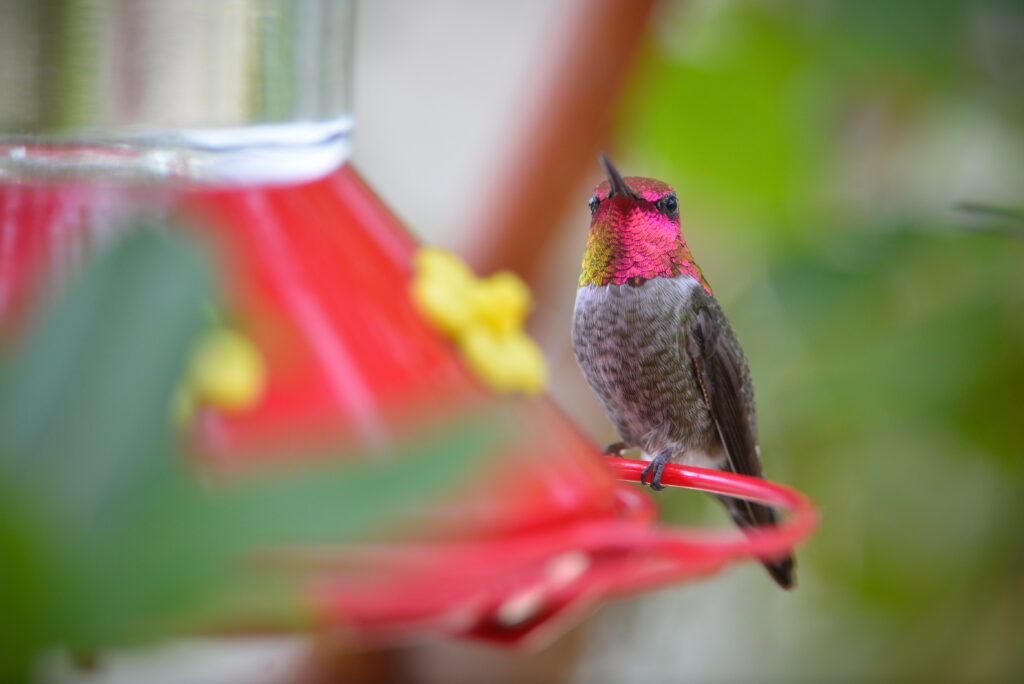An Anna’s Hummingbird perches on a feeder. Photo by Adam White.

How to Prevent Birds from Striking your Windows
August 10, 2022
By Alix Soliman, Communications & Outreach Coordinator
From a bird’s perspective, windows reflect the outside world and create the illusion of a seamless continuation of surrounding habitat, which can lead to what’s known as a “bird strike.” According to the Audubon Society, between 54 and 76 percent of window collisions prove fatal, killing almost one billion birds in the United States every year.
The Santa Lucia Range is located within the Pacific Flyway, a major migration route for birds spanning from Alaska and Canada down through California and into South America. As the sky-faring migrants journey thousands of miles between breeding grounds and feeding grounds, many species must rest and refuel in places known as “stopover sites,” famous in the bird-watching world for their high concentration of species.
Monterey Bay is an important stopover site thanks to the nutrient rich coastal waters that support an abundance of anchovies, sardines, squid, krill, and plankton for these hungry migrants to feast on. Coastal wetlands and protected shorelines, such as the Elkhorn Slough Reserve and Point Lobos, offer safe refuges for weary avian travelers. Monterey County also supports resident land bird species with an incredibly biodiverse mix of inland habitats including redwood forests, oak woodlands, grasslands, chaparral, riparian zones, and freshwater ponds. Annual migrants and residents make up a total of 500 native bird species, a remarkable 23 percent of all native bird species found in North America according to data from Birdlife International.
With a seemingly limitless gamut of species-specific niches, birds provide a range of vital ecosystem services such as controlling insect and rodent populations, pollinating plants and dispersing seeds, serving as both predator and prey in the food chain, and alerting humans to environmental concerns such as toxic pesticides. The drive to protect birds, however, must go beyond what they can do for us. We have an ethical responsibility to conserve biodiversity in its own right. As the American Bird Conservancy (ABC) puts it, “we should no more allow the loss of species than destroy a masterpiece of art.”
“With just a few simple actions, we can help limit bird strikes on The Preserve and protect some of our most sensitive species, including tricolored blackbirds, raptors, and a number of other species that are particularly susceptible to striking windows,” said Conservation Ecologist Dr. Brian Woodward.
To prevent bird strikes, we recommend retrofitting your windows so that birds will recognize them as impassable barriers. Certain designs like large, breezeway, and mirror windows, as well as those facing east and west, are more prone to collisions because they appear to offer a clear flight path.
There are several simple methods at various price points that have proven effective for reducing bird strikes. It’s important to research which option will work best for you and your home, and to pay close attention to the “threat factor” rating of the product. According to ABC, products with a threat factor rating of 30 or less should reduce collisions by at least 50 percent. The lower the threat factor rating, the more effective the product or method is at preventing collision.
Here are a few of the most popular retrofit options on the market today:
- Etched patterns: Etching patterns onto your windows is a permanent deterrent to bird strikes. Viracon uses the silk screen method while Walker uses acid-etching, and both provide a range of patterns.
- Window films and tints: Products like those offered by CollidEscape and Decorative Films are applied to the outside of a window to disrupt the reflection off the outside surface that birds perceive as a continuation of their environment.
- UV Applications: Unlike humans, birds are able to see light in the ultraviolet spectrum, making semi-temporary UV window patterns and UV paint pens a good alternative.
- Tape or nylon strings: For a quick, easy DIY solution, consider using anti-collision tape or hanging paracord vertically in front of your window no more than four inches apart.
- External screens: Typical window screens intended to keep bugs out or bird-specific screens can block the flight path, allowing birds to safely bounce off of the screen.
- Awnings: Installing awnings or other shade structures above your windows can reduce the sky reflection that causes birds not to see a barrier.
If you’re in the process of building or renovating, you may consider incorporating bird safety measures into your design. Products like Ornilux and GlasPro Bird Safe glass incorporate UV patterns into the glass fabrication process, providing an elegant bird protection option that maintains the clear look of the glass. Another option is to design the building such that the glass is angled downward and reflects the ground instead of the sky.
Whichever option you choose, taking action to protect birds from window strikes is an important step to coexisting peacefully with the wildlife in your neighborhood. As the greatest barrier to reducing bird strikes on a large scale is a lack of public awareness, please forward this information to your neighbors, family, and friends so that they too can participate in bird protection efforts at home.
Please note that this article does not provide an exhaustive list of bird-safe products and methods. For a wider variety, check out the American Bird Conservancy’s glass collisions products and solutions database. For questions regarding human-wildlife interactions, please contact Conservation Ecologist Dr. Brian Woodward at [email protected].
The Santa Lucia Conservancy is a 501(c)(3) nonprofit organization and does not receive payment for the promotion of products or companies.